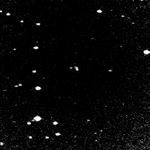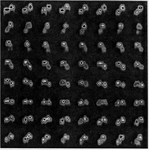|
Chapter 3: The Near-Earth-Object Population
|
| 3.1 | 3.2 | 3.3 | 3.4 | Contents |
3.2 Asteroids and Comets in Near-Earth Space
In 1989 there were 90 known ECAs (Shoemaker 1990), while 128 ECAs were known as the time this Workshop convened in June 1991 (Appendix A). None of them is today a hazard, since none is currently on an orbit that permits collision with the Earth. But all of them are capable of evolving into Earth-impact trajectories over the next few thousand years. And, in fact, it is estimated that 20 to 40 percent of the ECAs will ultimately collide with our planet (Wetherhill, 1979; Shoemaker and others, 1990). The others will either be ejected from the inner solar system through a close encounter with the Earth or will impact or be ejected by one of the other planets before they reach the Earth.
The 128 known ECAs are comprised of 11 Atens (9 percent), 85 Apollos (66 percent), and 32 Earth-crossing Amors (25 percent). Sixty-one of these have received permanent catalog numbers, implying their orbits are well established, while preliminary orbits are in hand for 51 others. The remaining 16 are considered lost, meaning their orbits are not well enough known to predict the current locations of these bodies. Further observations of them will occur only through serendipitous rediscovery.
All ECAs brighter than absolute magnitude 13.5 are believed to have been discovered. (The absolute magnitude is defined as the apparent magnitude the object would have if it were 1 Astronomical Unit (AU), or 150 million kilometers, from both the Earth and Sun). Translated to sizes, this means all ECAs larger than 14 km have been detected for the case of low reflectivity (dark) bodies, such as C-class asteroids. The limiting diameter for a complete survey is about 7 km for more reflective objects, such as S-class asteroids. We estimate that only about 35 percent of the ECAs having absolute magnitudes brighter than 15.0 (6 and 3 km diameters, respectively, for the dark and bright cases) have been discovered. At absolute magnitude 16 (4 and 2 km), the estimated completeness is only 15 percent, while at absolute magnitude 17.7 (2 and 1 km), it is only about 7 percent. The largest ECAs are 1627 Ivar and 1580 Betulia, each with diameter of about 8 km, or slightly smaller than the object whose impact ended the Cretaceous. The smallest ECAs yet discovered are 1991 BA, an object that passed within 0.0011 AU (one-half the distance to the Moon) in January 1991, 1991 TU, which passed within 0.049 AU in October 1991; both have diameters of about 10 m.
Based on search statistics and the lunar cratering record, we estimate that the population of Earth-crossing asteroids can be approximated by several power lows, which reflect a general exponential increase in the numbers of ECAs as we go to smaller and smaller sizes. Each segment of this distribution can be described, mathematically, as follows, where N is the number of objects within a given size interval:
 |
where k is a constant and b is the power-law exponent. Although
the general form of this size distribution is demonstrated by
observations, The detailed distribution is not well known. The
simulations that will be described in subsequent chapters require
a model for the asteroid population, however. For our ECA population
model, we estimate that changes in the power law occur at diameters
of 0.25 and 2.5 km, and have adopted exponents 0f -2.6 (D<=
0.25 km), -2.0 (0.25 KM < D <= 2.5 KM), AND -4.3 (D >
2.5 KM).
Estimates for the total number of asteroids having diameters larger than values of particular interest are shown in Figure 3.1 by the solid curve. Specific population estimates at sizes of interest are indicated in the Figure, where our uncertainties are bounded by the dashed lines. For example, we estimate there are 2,100 ECAs larger than 1 km in diameter, with an uncertainty of a factor of two.
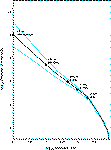 |
|
|
Active comets can also cross the Earth's orbit with the potential
for collision. From Everhart's (1967) determination of cometary
orbits, it can be inferred that 10 to 20 percent of all short-period
comets are Earth-crossing. Using this fraction and the frequency
distribution for the number of short-period comets derived by
Shoemaker and Wolfe (1982), we estimate that the population of
short-period comets having Earth-crossing orbits is likely to
comprise about 30 +/- 10 objects larger than 1 km diameter, 125
+/- 30 larger than 0.5 km diameter, and 3000 +/- 1000 larger
than 0.1 km diameter. Comparing these numbers with those for
the ECA population in Figure 3.1 shows that at any given size,
short-period comets contribute only an additional 1 percent or
so to the total population. This contribution is quite small
compared to the estimated uncertainty in the ECA population.
As stated previously, an object that displays no apparent atmosphere
or tail is classified as an asteroid even if its orbital properties
are similar to that of a short-period comet. Dormant or extinct
short-period comet nuclei are therefore likely members of the
ECA population, and such objects are implicitly included in the
ECA estimates given above.
Although about 700 very-long-period or new comets are known to have passed through the inner solar system during recorded history, their total population is difficult to characterize. Only about half of these comets had Earth-crossing orbits and thus can be termed ECCs, where we define a comet to be an ECC if it has a period greater than 20 years and a perihelion less than 1.017 AU. Fernandez and Ip (1991) estimate a flux of about three ECCs brighter than absolute magnitude of10.5 per year. From work by Weissman (1991), we estimate these bodies to be between 3 and 8 km in diameter. From their orbital and size distributions, we estimate that ECCs are about five times more abundant than Earth-crossing short-period comets. Thus the combined total number of Earth-crossing comets is only about 5 -10 percent that of the ECA population. As noted previously, however, the lon-period comets contribute disproportionately to the impact flux because of their higher impact speeds, relative to those of the asteroids. Indeed, we estimate that they contribute about 25 percent of the total NEO hazard. To model the flux of ECCs that move inside the Earth's orbit, we assume a power-law distribution of 180 D exp(-1.97) per year. This flux appears to be two or three times larger than others have estimated because our model associated a larger nucleus diameter with a given apparent brightness, but the predicted number of ECCs of a given brightness should remain unaffected.
| 3.1 | 3.2 | 3.3 | 3.4 | Contents |
3.3 Origin and Fate of NEOs
Near-Earth objects are efficiently removed from the solar system by collisions or gravitational interactions with the terrestrial planets on time-scales of 10 -100 million years. Thus the NEO population we see today must be continually resupplied, as any remnant primordial population would have long been depleted. This process of depletion has had consequences for the geological evolution of the terrestrial planets, as evidenced by the existence of large impact basins and craters. Removal of NEOs by impacts may also have had profound consequences for biological evolution on Earth.
At the root for understanding the origin of NEOs is the need to identify their source of resupply. Cometary objects appear to be supplied from either the very distant reservoir called the Oort cloud or the somewhat closer disk called the Kuiper belt, which have preserved unprocessed (unheated) material from the time of the solar system's formation. The great age and primitive chemistry of comets make their study vital to our understanding of planetary accretion and chemistry. Galactic tidal effects and random gravitational perturbations from passing stars or molecular clouds can alter the orbits of some Oort cloud members causing them to make a close approach to the Sun. Although the comets initially have long orbital periods, they can be perturbed into short period orbits through interactions with Jupiter and the other planets.
Two sources have been hypothesized for supplying asteroidal NEOs, both with profound implications on our understanding of solar system evolution. The first hypothesis is that they are derived from main belt asteroids through the process of chaotic dynamics. It has been shown that objects orbiting in a 3:1 mean motion resonance with Jupiter (the location of one of the "Kirkwood Gaps" at 2.5 AU) exhibit chaotic increases in their orbital eccentricity allowing their orbits to cross that of the terrestrial planets. In addition to the dynamical calculations that support this hypothesis, observational evidence shows that many NEOs are compositionally similar to main-belt asteroids. In many ways, they seem to resemble the smaller main belt asteroids, and both theory and observation support the hypothesis that both groups consist primarily of fragments generated in occasional collisions between main belt asteroids.
A second proposed source for NEOs is from dormant or extinct comet nuclei. The end stages of a comet's life are poorly understood, with one scenario being that as surface volatiles are depleted an inert mantle forms which effectively seals off and insulates volatiles within the interior. Without the presence of an atmosphere or tail, such a body would have an asteroidal appearance. Observational evidence that supports this hypothesis includes several asteroidal NEOs that have orbits similar to known short period comets. At least one of these cataloged asteroids, 3200 Phaethon, is known to be associated with a meteor stream (the Geminids). Previously, meteor streams were known to be associated only with active comets. Further, the orbits of some asteroidal NEOs do not appear to follow strict gravitational dynamics, suggesting the action of some non-gravitational forces such as those associated with cometary activity.
| 3.1 | 3.2 | 3.3 | 3.4 | Contents |
3.4 Physical Properties of NEOs
The physical and compositional nature of asteroids and comets is inferred from telescopic observations aided by comparisons with the meteorites (Figure 3.2). Most meteorites appear to be fragments of asteroids, and in many cases it is possible to match the reflectance spectra of individual asteroids with those of meteorites measured in the laboratory. Most of this work has been done for the main belt asteroids, however, since the near-Earth asteroids are generally faint and must be observed within a rather narrow window of accessibility.
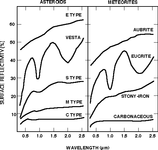 |
|
|
Although most known Earth-approaching asteroids have never been
observed for physical properties, and those that have been are
generally only poorly observed relative to the brighter main
belt asteroids, some things can be said about them. They exhibit
a diversity in inferred mineralogy approaching that in the rest
of the asteroid population. The majority are expected to be similar
to the dark C-type asteroids in general properties (presumably
moderately low-density, volatile-rich bodies, colored black due
to at least several percent of opaques). There are also a large
number of S types. (S's are thought to be either stony, chondrite-like
objects, stony-iron objects, or a combination of both.) In addition,
there are known examples of metallic bodies (probably like nickel-iron
alloy meteorites) and rocky, monomineralic bodies.
These asteroids are small and often quite irregular in shape; they also tend to have rather rapid spins, but there is a great diversity in such properties. Their densities have not been measured, but are inferred to be typical of rocky material (about 2-3 g/cm3). In only one case has an Earth-approaching object been imaged: 4769 Castalia (Figure 3.3). Remarkably, this radar image shows a highly elongated object that may be a contact-binary composed of two objects of comparable size. Although astronomers have presumed that these objects are coherent, intact bodies like large boulders, it is possible that some or many of them are aggregates, which may have little or no internal cohesion.
Only one asteroid has been investigated by a spacecraft: in October
1991, the Jupiter bound Galileo spacecraft passed within 1,600
km of the main belt asteroid 951 Gaspra (figure 3.4). Gaspra,
an irregularly shaped S-type asteroid, is slighlty larger than
the largest known ECAs.
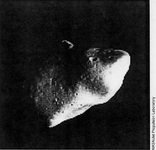 |
|
|
It is particularly uncertain what the physical properties of
comets (dead or alive) might be like. Only one comet has been
studied in detail: Comet Halley, which was the target of several
flyby spacecraft missions at the time of its last apparition
in 1986. The nucleus of Halley (Figure 3.4) is irregular and
dark, with an average diameter of about 10 km. Like other comets,
it is made of a combination of ice(s), rocks, and dust, with
much of the atmospheric outgassing near the Sun confined to discrete
plumes or jets. In general, the physical configuration of comets
is even more poorly understood than that of the small asteroids
, and many comets have been observed to split under rather modest
tidal and thermal forces. Their densities have not been measured
but are thought to be about 1 g/cc, although many different estimates
can be found in the scientific literature on comets. If we assume
that comets are homogeneous and have roughly the same composition
as Halley, then cometary nuclei are about half non-volatiles
and half ices by weight. The non-volatiles include both silicates
and organic materials. The primary ices (with percentages derived
for Halley) are water (80 percent) and carbon monoxide (15 percent),
plus lesser quantities of formaldehyde, carbon dioxide, methane,
ammonia, and hydrocyanic acid.
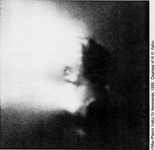 |
|
copyrightMax-Planck Insitut fur Aeronomie, 1986. Courtesy of H.U. Keller. |
The relationships between the brightness of comets, the size
of their solid nuclei, and their distance from the Sun are complex
and not fully understood. Two comets with known nuclear size
(both about 10 km diameter), Halley and IRAS-Iraki-Alcock, differed
by more than a factor of 100 in intrinsic brightness when near
1 AU from the Sun. Each well-observed intermediate or long period
comet has exhibited a different pattern of activity as it approached
and retreated from perihelion. Indeed, periodic comets exhibit
different patterns of activity on different returns. Though seldom
observed at solar distances greater than 5 AU, most long-period
comets evidently become active somewhere between 5 and 10 AU.
In some cases, weak intermittent activity has been observed at
even greater distances from the Sun.
For a study of impacts, it is not essential to know a great
deal about the physical nature of comets and asteroids. The most
important properties are simply their mass and impact velocity,
although it would make a difference if the projectile were double
or multiple and easily came apart as it entered the atmosphere.
However, any future program for intercepting and diverting an
incoming comet or asteroid will require detailed knowledge of
the configuration, density, cohesion, and composition of these
objects. For these reasons, in addition to their significance
for basic science, spacecraft missions to comets and near-Earth
asteroids are essential. The first opportunity for a detailed
study of a comet is provided by the NASA Comet Rendezvous and
Asteroid Flyby mission (CRAF), now planned to study Comet Kopff
in 2002 (CHECK). The opportunity for a similar study of a near-Earth
asteroid will depend on approval of the NASA Discovery line of
small planetary missions, the first of which is to be an asteroid
rendezvous.
|
|
|

